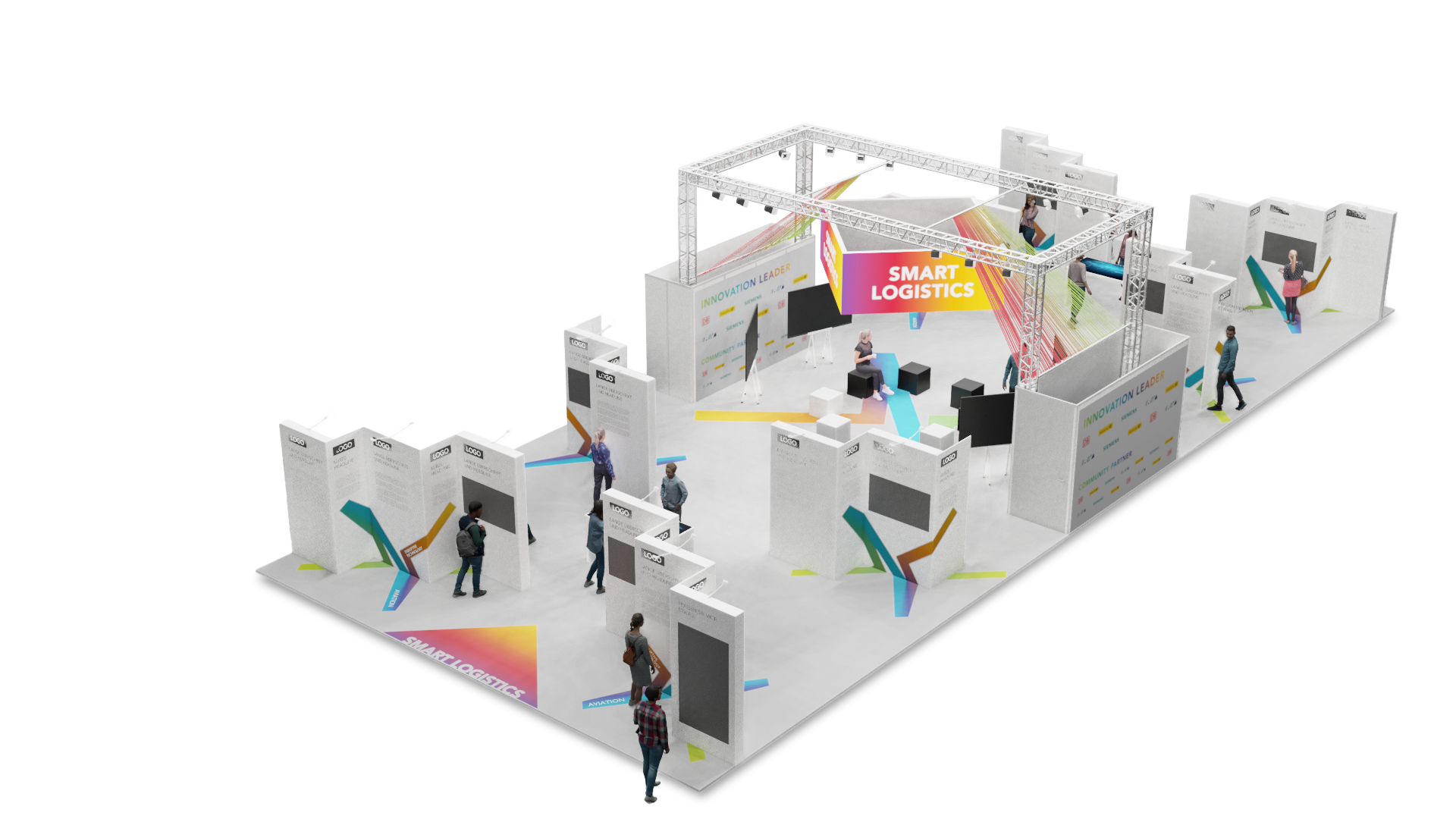THE Marketplace Concept
Unique reach and brand potential
The customised concept developed by motion-X in the form of innovative joint stands combines exhibition space, presentation, discussion and networking and was successfully implemented at Hypermotion Frankfurt 2021.
In the process, the marketplaces were developed as innovative joint stands in tune with the needs of both presenters and visitors. They form the centre of the clustered themes Mobility, Logistics and Green City and reflect the current and future key topics.
42 exhibitors presented at the marketplaces for mobility and logistics, including the Rhein-Main-Verkehrsbund, YUNEX, Logistics Alliance Germany (LAG), Exasol, Atos, Accso, KLU University, Wirtschaftsförderung Frankfurt and many more.
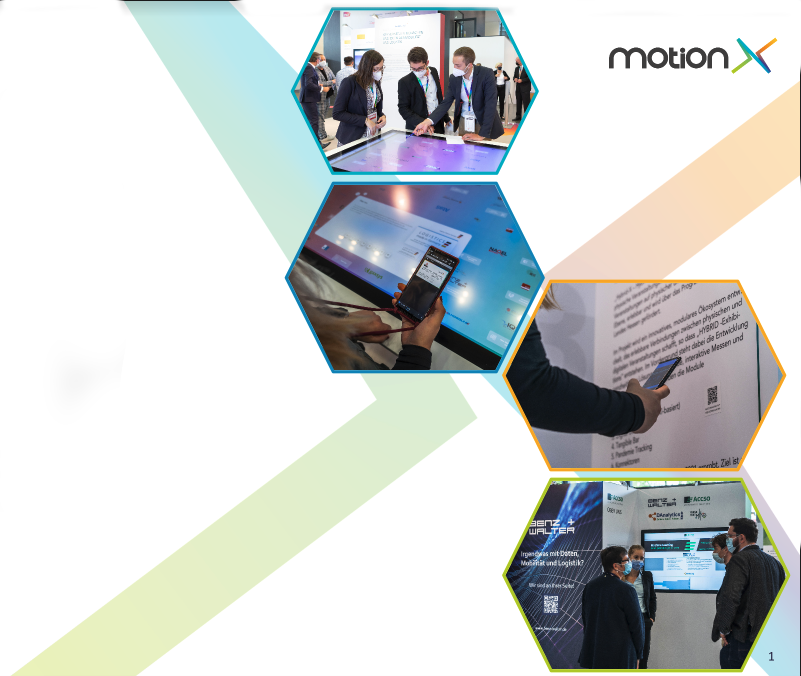
Connecting THEMES and Partners– 360/365 -
Marketplace participants at Hypermotion Frankfurt 2021
The content was available for 3 days on site and for 365 days at www.motion-x.net
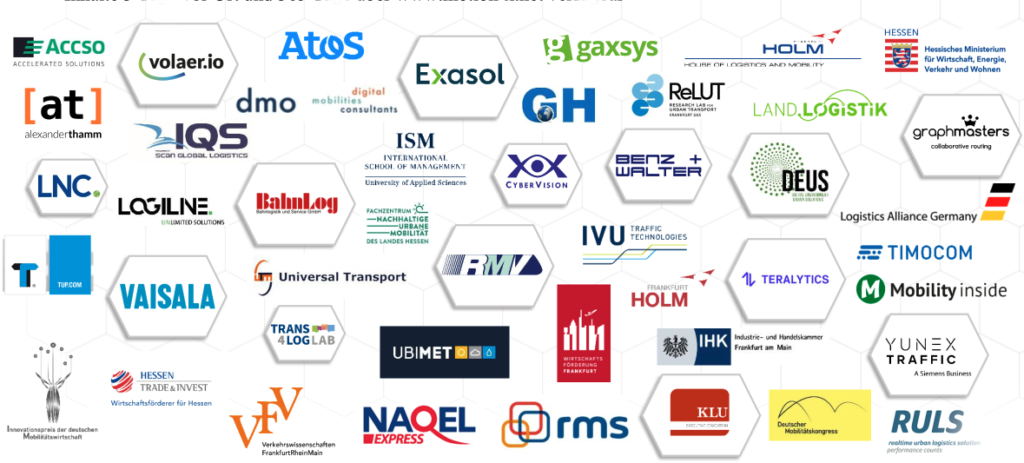
WHAT we work with
Innovative Marketplace Elements
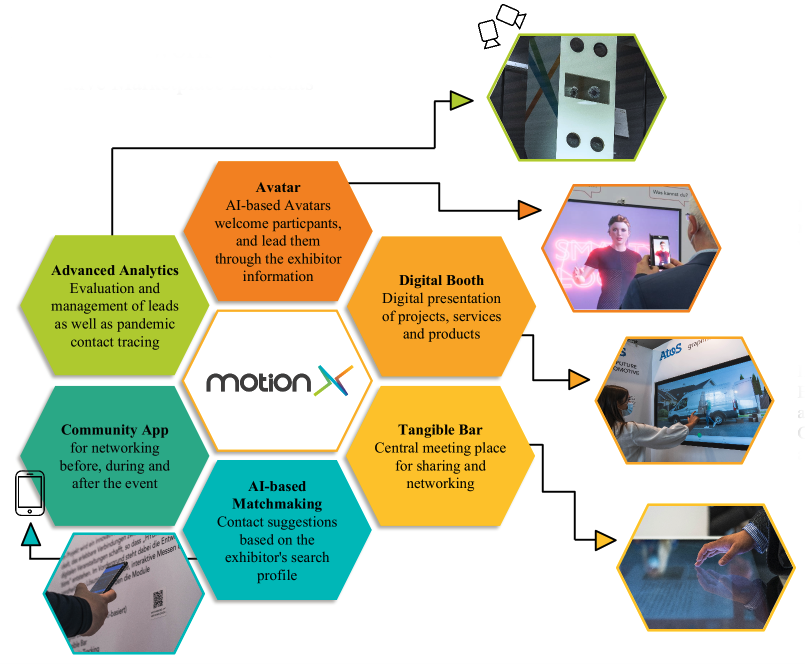
Integrated hybrid elements promote networking and interactive exchange between visitors and exhibitors – irrespective of their type of presence. The hybrid modules were funded through the Distr@l programme of the State of Hesse and integrated and tested on the marketplace as part of the Hybrid-X project (Hybrid Integration of Digital Elements in Physical Event Concepts). The project was awarded a silver medal by the Hessian State Chancellery Minister for Digital Strategy and Development.
HOW we work
Structure according to focus topics
The focus topics connect industries and participants into one community!
The Smart Logistics and Future Mobility marketplaces are the meeting point for participants with innovators, logistics designers, digital champions and "game changers" from the market.
The marketplaces were each designed according to 8 focus topics. The latest ideas for tomorrow's mobility, the best approaches for networking and developing infrastructure on land, water and in the air, as well as innovations and their concrete application in cities and regions will be presented under thematically clustered presentation walls.
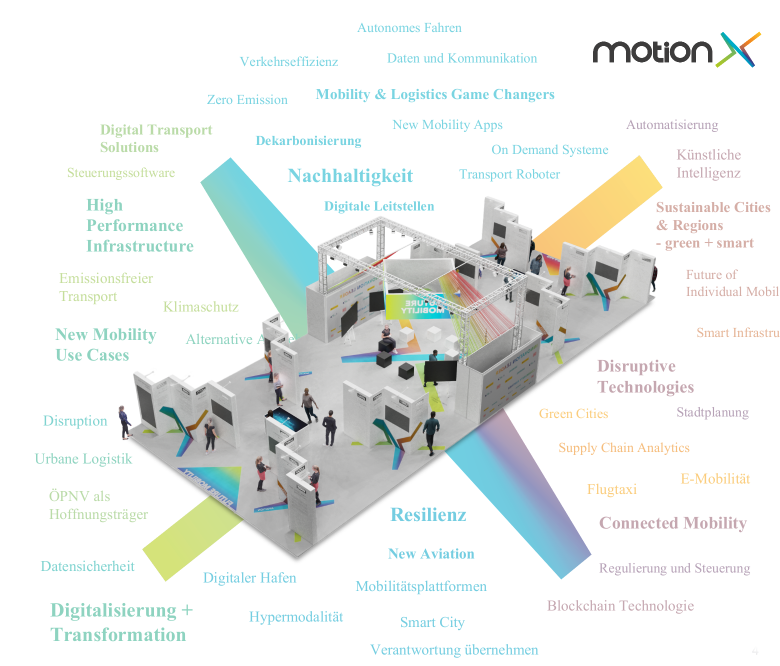
Marketplace Gallery
Connect, test, visualise
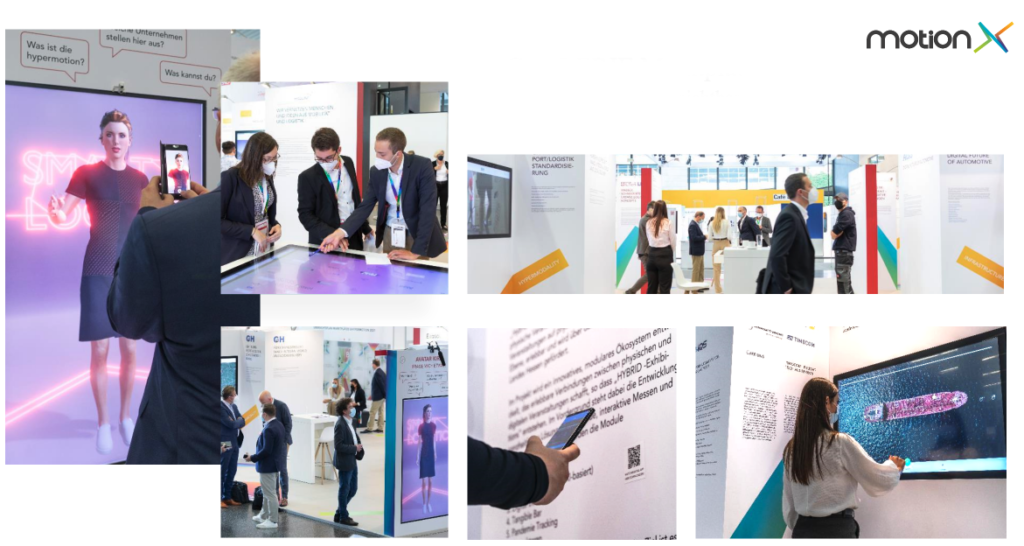
THE MARKETPLACE @HYPERMOTION 2021
FUTURE MOBIILITY
The latest ideas for tomorrow's mobility, the best approaches for networking and developing infrastructure on land, water and in the air, as well as innovations and their concrete application in cities and regions.
FOCUSTOPICS
The increase in intelligent services and software is becoming more and more important, so that mobility is being reinvented through the use of information and communication technologies. This includes the combination of different ways of getting around and all available means of transport. Integrated traffic planning, data security and sovereignty, and 5G communication are the focus of Connected Mobility:
Intelligent, networked infrastructure is the cornerstone of smart cities. Technical and structural infrastructure can save resources through intelligent networking. Synergy effects can be formed through better utilization of existing infrastructure. Networked, cloud-based digital offerings enable a rapid response to changing conditions for people and the environment. The aim of smart infrastructure is to conserve resources and avoid pollution by, for example, optimizing and automating processes through their networking so that they save energy. Smart infrastructure includes, among other things, the digitalization of critical infrastructures (roads, railways, ports, airports), digital twins and intelligent transport systems (ITS).
Innovative, sustainable technologies, the changing ecological understanding, political measures for social integration and new mobility concepts will also successively transform cities into places worth living in. Today, Sustainable Cities & Regions focuses in particular on energy and mobility in connection with climate protection and increasing quality of life. Areas of application include, in particular, emission-free supply and disposal, the procurement of renewable energy, urban transport planning, urban space development, and logistics and mobility hubs.
The entire transport spectrum is being transformed into digital solutions, which should enable transparency across different modes of transport. Infrastructure, vehicles, travelers and goods provide information in real time. When this data and information is processed, conclusions can be drawn and an intelligent transport system is created. Data-based, proactive, environmentally sensitive traffic management, Big Data Analytics, real-time traffic control as well as data-based (risk) management are the focus of Digital Transport Solutions.
The availability of data through digitization and the digital transformation of business models are leading to new use cases and offerings in mobility. Changing needs and different user behavior are increasing demand and accelerating the process toward new mobility solutions. Offerings such as mobility-as-a-service, mobility platforms, on-demand mobility and micromobility are already popular today.
The way we get around is changing radically. Intermodal mobility, i.e., the use of different modes of transport on one route, combines individual mobility with public transport. Intelligent networking of means of transport is therefore a prerequisite. Mobility users decide for themselves when and where they want to use which means of transport. Keywords here are individual public transport, the future of commuting, new mobility apps and new mobility platforms. But also the future, more sustainable locomotion, such as e-mobility and alternative drives play a major role here.
The expansion of urban transportation systems into airspace is taking place through the use of drones and flybots. The new form of mobility is intended to act as a congestion solver for cities. In the future, autonomous air cabs will be the main transport component in the New Aviation theme, and transport drones and flybots are being planned. In this context, intelligent infrastructure at (regional) airports is also important.
Technological progress is also changing the mobility sector. Disruptive technologies are innovations that replace existing technologies or completely displace them from the market. These innovations enable companies to offer new products and services or even develop new business models. In mobility, people often talk about megatrends such as, autonomous driving, shared mobility (shared open data platforms), connectivity, electromobility, hyperloop and blockchain technology.
SMART LOGISTICS
Resilience, innovation and performance, the Smart Logistics Marketplace is about solutions for the successful transformation of cities, regions, companies and supply chains. The meeting place for logistics designers & digital champions!
FOCUSTOPICS
Logistics is the planning and control of information and goods flows across value chains. New technologies are being used to make logistics more efficient, i.e. smarter. For example, autonomous and system-supported decisions can be made to improve logistics value chains. Smart logistics solutions include last mile logistics apps, last mile logistics platforms, supply chain analytics, and solutions for zero-emission transportation and urban logistics coordination.
Intelligent, networked infrastructure is the cornerstone of smart cities. Technical and structural infrastructure can save resources through intelligent networking. Synergy effects can be formed through better utilization of existing infrastructure. Networked, cloud-based digital offerings enable a rapid response to changing conditions for people and the environment. The aim of smart infrastructure is to conserve resources and avoid pollution by, for example, optimizing and automating processes through their networking so that they save energy. Smart infrastructure includes, among other things, the digitalization of critical infrastructures (roads, railways, ports, airports), digital twins and intelligent transport systems (ITS).
The entire transport spectrum is being transformed into digital solutions, which should enable transparency across different modes of transport. Infrastructure, vehicles, travelers and goods provide information in real time. When this data and information is processed, conclusions can be drawn and an intelligent transport system is created. Data-based, proactive, environmentally sensitive traffic management, Big Data Analytics, real-time traffic control as well as data-based (risk) management are the focus of Digital Transport Solutions.
Technological progress is also changing the mobility sector. Disruptive technologies are innovations that replace existing technologies or completely displace them from the market. These innovations enable companies to offer new products and services or even develop new business models. In mobility, people often talk about megatrends such as, autonomous driving, shared mobility (shared open data platforms), connectivity, electromobility, hyperloop and blockchain technology.
High-performance infrastructures are intelligent infrastructures that use IT to provide information on the entire infrastructure system in order to identify needs and optimize availability and performance requirements. Examples include digital ports, airports, terminals, and smart stations that deliver high infrastructure performance through the use of IoT solutions and 5G communications.
Green - Lean - Smart is about sustainable, efficient logistics supported by modern technologies. Logistics processes are optimized with the help of new technologies (e.g. artificial intelligence) and waste is reduced. In particular, returns, unnecessary journeys and routes are to be minimized with regard to sustainability. The topics here include fast track innovations, innovative material flow planning and control, and cooperative logistics planning.
Resilience means being able to draw on resources in times of crisis. In logistics, resilience means making value chains more resistant in order to ensure long-term security of supply. In this context, there is often talk of supply chain resilience as well as climate-neutral supply chains. In mobility, resilience is necessary to counter external events such as disruptions, accidents or weather extremes and to maintain the transport network. To achieve sustainability and resilience, the focus must be not only on climate change but also on developments such as demographic change and social and economic change.
Digitization in itself is a process in which analog media are converted into bits and bytes so that they can be retrieved in digital form. In digital transformation, it is not just processes that are digitized, but entire business areas. Entirely new business models are created. Within the digital transformation, companies look for innovative solutions and optimize processes. Disruptive technologies, such as the Internet of Things, are used to drive transformation in mobility (e.g., autonomous driving) and logistics (Industry 4.0).
- Presentation of your projects and products on thematically clustered presentation walls
- Knowledge exchange and discussion rounds in the arena
- Central meeting point at the Tangible Bar
- Exclusive community app for networking before, after and during the event
- Best practice and visions
- New mobility concepts and models
- Room for discussions
- Interdisciplinary networking
- Presentation of your projects and products on thematically clustered presentation walls
- Knowledge exchange and discussion rounds in the arena
- Central meeting point in the communication area
- Exclusive community app for networking before, after and during the event
- Future topics and solutions in logistics and supply chain management
- Innovative presentation
- Top - Lead Generation
- New Business


